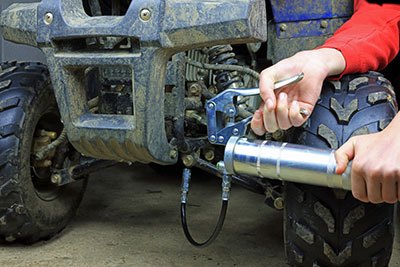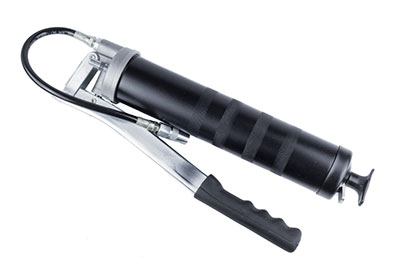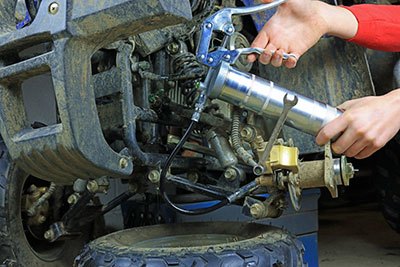Do you work in the agriculture industry and find yourself constantly using grease guns? If yes, this is guide is for you!
You will learn:
- the components
- different types available
- tips on proper usage and maintenance
- benefits.
Keep reading for our comprehensive breakdown of everything there is to know about your trusty grease gun.
Take away key points:
- Grease guns work in such a way as to provide a positive displacement for optimal use
- There are different types of guns
- You need to maintain them correctly for more convenience
Table of Contents
- All you need to know about the grease guns
- FAQs
- What is the end of a grease gun called?
- How to get a grease gun unstuck?
- How to remove the needle from the grease gun?
- How many pumps of a grease gun?
- How to use a grease gun needle adapter?
- Who makes the best grease gun coupler?
- How do you replace a cartridge with a grease gun?
- How do you put the tip of a grease gun back together?
- Do grease guns come with grease?
- Summary
All you need to know about the grease guns
Below you can find all the crucial information regarding grease guns, their benefits, usage, and the proper grease gun operation.
You will also find different types of available models and their main parts to ensure the grease guns function correctly.
Let’s see.
What is a grease gun and how does it work?
A grease gun is a tool used to apply lubricant in the form of grease to machines and mechanisms. It is commonly used on tractors, as it allows for the easy and efficient lubrication of moving parts.
The grease gun works by forcing the grease through a nozzle and onto the part that needs lubrication. This helps reduce friction between two surfaces, which can cause wear and tear over time.

What are grease gun types?
Grease guns are a useful tool for lubricating machinery and other moving parts. There are several different types of grease guns available, each with its advantages and disadvantages.
The most common types of grease guns are:
- lever guns
- pistol-grip guns,
- cordless guns (pistol grip)
- pneumatic guns (pistol grip).
1. Lever-type grease gun
Lever guns are the simplest type of grease gun and require the user to manually pump the handle to generate pressure and dispense the lubricant.
Manual grease guns are relatively inexpensive but require more effort than other types of grease guns. The guns provide 1.28 grams of grease needed for oil-lubricated machines.
2. Pistol-grip grease gun types
Pistol-grip guns have a trigger mechanism that allows for easier operation than lever guns. They also provide more control over the amount of lubricant being dispensed.
The pneumatic grease guns are manual grease models, similar to the lever models.
3. Cordless grease guns (battery-powered grease gun models)
Cordless grease guns use rechargeable batteries to power them, making them convenient for use in remote locations or where there is no access to an electrical outlet. This type of grease gun is also a pistol-grip one, so you can easily manage it, for the effortless one-handed pumping method.
4. Pneumatic grease gun
Pneumatic grease guns use compressed air to generate pressure and dispense lubricants quickly and accurately. The pneumatic grease gun is also a pistol-grip model.
It’s typically used in industrial settings where large amounts of lubricant need to be applied quickly and efficiently. The gun uses the hose activating mechanism for better precision when applying the oil.
The grease gun provides positive displacement with each trigger. It’s a manual grease gun operating with the hand pump and you can adjust it to grease your oil-lubricated machines easily for the best machine reliability.
No matter which type of grease gun you choose, you need to find the one that is most suitable for your application and properly maintained so that it will last for years to come.
Main parts of the grease gun
Grease guns are excellent tools for extending machinery life and ensuring the grease-lubricated machines are working optimally, without any issues for an extended period.
The grease gun is mainly used to supply grease lubricant to the bearings of rotating equipment, such as shafts. Grease guns come in a variety of shapes and sizes, but all have the same basic parts.
1. Barrel
The most important part of a grease gun is the barrel, which holds the grease. The barrel is the exterior case that holds either a replaceable grease tube or bulk-stored lubricant. The barrel is typically made of metal or plastic, and it can be filled with either manual grease guns or electric pumps.
The nozzle at the end of the barrel is used to direct the grease into small openings on the grease-lubricated machines or another machine’s moving surfaces, requiring grease for optimal work.
2. Handle
The handle is another crucial part of a grease gun. the handle will provide leverage when pumping out grease from the barrel and will help you control how much grease comes out at once. Handles can be made from metal, plastic, or rubber, based on the type of grease gun you are using.
The handle works with the trigger in manual configurations of the grease gun, applying grease to the barrel. Then, the barrel works as the bulk storage option and houses the grease supplied from that bulk storage, or the grease tube.
3. Plunger
The plunger is in charge of pushing out the grease from the barrel. It is usually made from plastic or metal and comes with a spring-loaded system. The mechanism helps control how much pressure is applied when pumping out the grease.
The spring provides uniform pressure onto the grease gun plunger. The follower rod (barrel rod, piston rod, plunger rod will help the plunger follow a uniform path, keeping too much pressure and compressed air directed to the bottom end of the grease tube. It will pull the spring prior to inserting a new grease tube.
4. Grease tube
A grease tube is another important part of a grease gun, holding the lubricant. It is typically made of metal or plastic and is connected to the handle of the gun. The fixed tube is also known as the grease cartridge.
The fixed tube attached to the head of the grease gun uses either the grease tube or the hose to keep it as the connection point to the grease gun.
The tube is filled with the lubricant and then inserted into the gun’s barrel, which contains a piston that forces the lubricant through a nozzle when you pull the trigger.
The grease tube comes in various sizes and is designed for different types of lubricants.
5. The head
The head of the grease gun uses the grease pathways and valves to travel to the fixed tube or the flexible hose from the barrel.
Other parts of the grease gun

Here are additional parts of the grease gun, and they include the following:
- The lever in manual configurations of grease guns is used to pump grease out of the barrel into the hose or tube.
- A hydraulic coupler (hydraulic connector) attaches the flexible hose and the fixed tube to the head of the grease gun, while a filler nipple injects new grease from a pump.
- The air-release nipple allows air to escape after the fresh lubricant has been pumped.
- The spring provides pressure on top of the plunger, while the follower rod ensures the plunger follows a uniform path.
- A follower handle offers a grip when pulling back on the follower rod prior to adding a new grease tube.
- Both flexible and rigid hoses are interchangeable for connecting couplers with ease.
- The filler nipple presents the injection point for grease from a filler pump.
- The filler pump serves as the main injection point of the grease lubricant.
Grease gun accessories
Finally, there are various accessories available for use with a grease gun such as extension tubes, couplers, adapters, and swivel fittings that make it easier to reach hard-to-reach areas when lubricating machinery or other objects. Let’s examine them better.
Grease gun extension tubes are ideal to extend the reach of a grease gun, allowing it to access hard-to-reach areas. These tubes come in various lengths and are made from steel with a bright zinc-plated finish for durability.
The ends of the tube have high-strength rolled threads that fit onto outlets of grease guns that pump out lubricants such as grease or oil. Extension tubes can be rigid or curved and range from 6 inches to 18 inches long.
Grease gun meters can be added to a grease gun to help conserve lubricant.
Plastic caps offer benefits such as preventing corrosion and containing debris while color-coding can prevent cross-contamination.
Sonic/ultrasonic accessories are also available for purchase.
A needle-end adapter ensures the best precision of grease used in tight spaces, without excess oil.
A three-jaw swivel coupler is ideal for the application of various locking positions, fitting well for other applications.
A grease fitting is also famous as a Zerk fitting, Alemite fitting, or grease nipple. The grease fitting serves as the main connection point between the grease connector and the lubrication point. The Zerk fitting is the main connection part for the grease connector.
The standard hydraulic fitting is the most popular model and can be either angled or upright. A button-head type is ideal when large volumes of lubricant need to be added, while a flush-type grease fitting is preferred in tight spaces.
The standard protruding fittings are ideal for a grease gun when the space is limited.
On the other hand, the pressure-relief vent fitting prevents potential damage caused by excessive pressure buildup.
Overall, understanding how each part works together will help you get better results when using your grease gun for lubrication purposes. With proper maintenance and care, your grease gun should last you many years!
How to decide what to use: flexible hose vs. fixed tube
You can decide whether to use the flexible hose or fixed tube based on the machine’s grease-fitting, ease of location, and the kind of grease gun model. The fixed tube presents a rigid form of the flexible hose.
A flexible hose is an ideal option for hard-to-reach locations, while lever-style guns that need two hands to pump lubricant would be better suited with a fixed tube.
Grease gun benefits
One of the main advantages of using these guns is that they allow you to apply targeted lubrication to fittings with precision. This helps ensure that the right amount of lubricant is applied in the right places, which can help improve the performance of your machinery. Additionally, grease guns make it easier to access hard-to-reach areas that may not be accessible with other tools.
The second benefit of using grease guns is that they help reduce friction and wear on parts. The lubricant applied by a grease gun helps reduce friction between moving parts. This can help extend the life of your machinery, increase machine reliability, and reduce maintenance costs over time. Additionally, using a grease gun can help protect against corrosion caused by moisture or other environmental factors.
Finally, using a grease gun can increase the efficiency of your system by reducing energy consumption while also improving performance. The lubricant applied by a grease gun helps reduce friction between moving parts. The flexible positioning allows the flexible hose to move more smoothly and efficiently without expending as much energy as it would without it. This can help save money on energy costs over time.
Proper maintenance of grease guns

Proper maintenance of grease guns is essential to ensure that they last and perform as expected. Grease guns should be stored in a clean, fireproof cabinet with the plunger disengaged from the tube.
Use a clean shop rag or lint-free cloth to clear away any debris before use. Inspect the fittings, bearing seals, a standard hydraulic coupler, follower handle or suction fill for any signs of damaged seals before applying new grease. Replace the parts if necessary.
You should also standardize fitting sizes and types when possible. After each use, wipe down the grease gun with a dry cloth to remove excess grease or debris.
Cleaning your grease gun periodically with water mixed with an anti-grease solution will keep it in tip-top condition, preventing fluid friction and other damage types.
FAQs
What is the end of a grease gun called?
The end is called the hydraulic coupler.
How to get a grease gun unstuck?
– Unscrew the flexible hose or rigid extension from the gun
– Use solvent for wiggling the pin back and forth
– Use a device injecting high-pressure solvent into the fitting to loosen it
How to remove the needle from the grease gun?
You can use the needle adapter and remove the needle without the need to disassemble the entire gun.
How many pumps of a grease gun?
There are air-operated pumps, manual lever pumps, or electric motor pumps.
How to use a grease gun needle adapter?
- Attach the adapter to your grease gun,
- Insert the needle into the desired area,
- Pull the trigger to dispense the lubricant.
Who makes the best grease gun coupler?
LockNLube makes the best grease gun couplers.
How do you replace a cartridge with a grease gun?
- Attach the cartridge to the end of the grease gun and fasten it securely.
- Press down on the plunger to reach the bottom of the barrel.
- Pull back on the trigger and push out the grease.
How do you put the tip of a grease gun back together?
– Unscrew the nozzle to find the ball and spring inside
– Stick the ball to the spring with a dab of grease
– Screw the housing and body back together
– Ensure there are no leaks and the lever is lightweight
Do grease guns come with grease?
Yes, grease guns come with grease.
Summary
As you can see, there are various parts the guns use for lubricating your machines and ensuring the best use.
Find their purpose and way of use to provide the best operating standards while performing different tasks.
